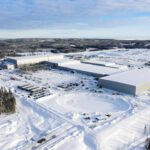A whopping 34-40 percent of the food produced in the United States goes uneaten each year. All that food waste adds up to an estimated 24 percent of materials in municipal solid waste landfills, which in turn produces an outsized 58 percent of the methane those landfills emit into the environment. It’s no wonder that businesses and communities are increasingly seeking ways to reduce landfill-bound food—and to turn it into a source of clean energy.
One of the most effective ways to do both? Anaerobic digestion.
What Is Anaerobic Digestion?
Anaerobic digestion is a natural process by which microorganisms break down organic matter in a closed space completely absent of air. The process results in biogas—a renewable energy source—as well as a mix of digested materials.
Anaerobic digestion takes place in built systems called anaerobic digesters, biodigesters, or simply digesters. These are lagoons or tanks that take in organic waste and produce biogas and digested materials while mitigating foul smells and reducing pathogens and solid waste products.
Anaerobic digesters are able to process a variety of organic materials, including manure, food scraps, industrial residuals, sewage sludge, fats, oils, and greases.
Anaerobic digestion is one of the primary methods of reducing the environmental impact of wasted food, according to the EPA Wasted Food Scale—a new framework for prioritizing ways to prevent and divert wasted food from disposal.
What Are the Products of Anaerobic Digestion?
The primary products of anaerobic digestion are biogas and digestate.
Biogas
Biogas, or renewable natural gas (RNG), is a renewable energy source comprised primarily of methane and carbon dioxide, as well as small amounts of water vapor and other gases. Once the carbon dioxide and other gases are removed, only the methane—the primary component of natural gas—remains.
Businesses and communities can use biogas to power:
Combustion engines
Heat and electricity generators
Boilers and furnaces
Alternative-fuel vehicles
Homes and business
The quality of biogas varies. The fewer non-methane components present, the higher the energy value of the biogas.
Biogas that meets pipeline quality standards can be distributed directly into homes and businesses through the natural gas pipeline. Biogas can also be used to produce compressed natural gas (CNG) or liquefied natural gas (LNG).
Digestate
Digestate is what remains after the biogas is removed. It is a wet mixture, rich in nutrients and typically separated into a solid and a liquid. It can be made into a variety of useful products, including:
Fertilizers
Flower pots
Soil amendments
Livestock bedding
Digestate can be applied directly to the land to improve soil health and encourage plant growth. Through the recovery and reintroduction of nitrogen and phosphorus lost in the digestion process, digestate can also be made into concentrated nutrient products, such as struvite and ammonium sulfate fertilizers.
How Does Anaerobic Digestion Fit into the Circular Economy?
The role of anaerobic digestion in the circular economy is multifaceted, and the benefits are many. They include:
Diversion of Organics from Landfills
Anaerobic digestion is an eco-friendly alternative to landfilling organic components of municipal solid waste. Food scraps, commercial food processing waste, yard waste, and other organic materials can be separated from the waste stream and diverted to an anaerobic digestion system. Keeping organic materials out of landfills in this way dramatically reduces harmful methane emissions. It also dramatically boosts the supply of valuable nutrients (in the form of digestate) that can be used to improve soil health.
Sustainable Food Production
A safe and sustainable food supply is essential to life. The efficient use of water and nutrients for food cultivation, in turn, is essential to the food supply. Manure digesters on farms can convert the nutrients in raw manure into a more accessible form for plants to take in—increasing crop yield. These digesters can also generate heat and electricity, reducing a farm’s dependence on the grid or other nonrenewable energy sources.
Diversification of Farm Revenue
Finding new and diversified revenue sources is critical to the long-term financial stability of many farms. Manure digestion systems, again, offer an array of opportunities, including “tipping fees” for managing organic waste streams originating outside the farm, income from the sale of nutrient-rich digestate, and even payments for selling biogas-generated electricity to the local grid.
Energy Independence
Instead of—or in addition to—selling energy from biogas to the grid, farms can use it to power their own operations. This removes a farm’s reliance on outside sources of energy, especially nonrenewable ones, which is great for their bottom lines and for the planet.
How Has Rubicon Helped Companies Put Anaerobic Digestion to Work?
Rubicon is no stranger to anaerobic digestion and its value. Case in point? The company’s partnership with Pennsylvania-based Reinford Farms.
Under the program developed by Rubicon, a large national variety store chain sends its expired milk to Reinford Farms. Through anaerobic digestion, the milk is converted into biogas and digestate. The biogas Rainford Farms produces generates enough electricity to power their full 1,300 acres, with sufficient spare energy to power 500 homes through the local grid.
To learn more about how you can implement an anaerobic digestion program and start converting waste into valuable resources for your business, please contact us today.
—
To stay ahead of Rubicon’s announcements of new partnerships and collaborations around the world, be sure to follow us on LinkedIn, Facebook, and Twitter, or contact us today.
A whopping 34-40 percent of the food produced in the United States goes uneaten each year. All that food waste adds up to an estimated 24 percent of materials in municipal solid waste landfills, which in turn produces an outsized 58 percent of the methane those landfills emit into the environment. It’s no wonder that … Continued General Rubicon







